Tag archives: space travel
Spacesuit of the future, another ancient Pythagoras, Disney’s football analysis
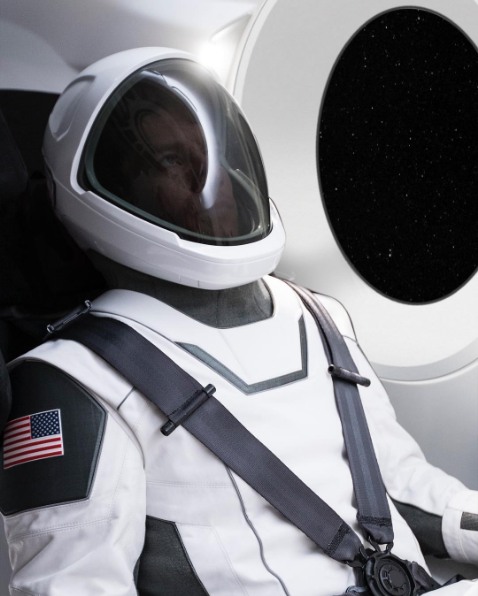
The stuff of movies: new SpaceX suit could be in a film (Courtesy: SpaceX)
By Sarah Tesh and Michael Banks
Astronauts on board the SpaceX Dragon Capsule will look like they’ve stepped out of a sci-fi film. This week, Elon Musk revealed his company’s futuristic space attire on Instagram. The suits are aesthetically very different to the bulky gear NASA astronauts currently wear, the Extravehicular Mobility Unit (EMU). They are even sleeker than NASA’s next generation Z-2 suit, which was previewed in 2015. The SpaceX garb are apparently also easier to walk in and more practical for everyday use. While not quite at the tech standard of fiction, the SpaceX suits definitely look the part.
View all posts by this author | View this author's profile
Playing poker with robots on Mars
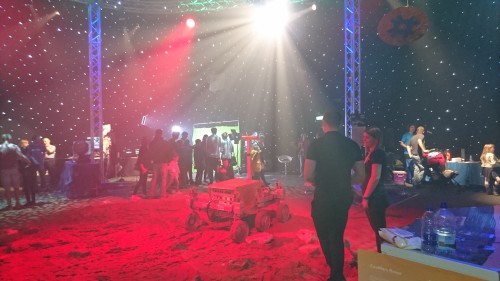
A prototype of the ExoMars rover trundles around inside the “space dome” at the Cheltenham Science Festival.
By Margaret Harris
How do you keep an astronaut alive, sane and (ideally) happy during a mission to Mars? The world’s space agencies would very much like to know the answer, but gathering data is tricky. The International Space Station (ISS) makes a good testbed for experiments on the physical effects of space travel, but psychologically speaking, ISS astronauts enjoy a huge advantage over their possible Mars-bound counterparts: if something goes badly wrong on the station, home is just a short Soyuz ride away. Martian astronauts, in contrast, will be on their own.
For this reason, space agencies have become interested in learning how people cope in extreme environments here on Earth, particularly in locations where rescue is not immediately possible. That’s why the European Space Agency (ESA) sent Beth Healey, a British medical doctor, to spend the winter of 2015 at Concordia Research Station, a remote base in the interior of Antarctica. During the continent’s nine-month-long winter, temperatures at Concordia can plunge as low as –80 °C, making it inaccessible even to aeroplanes, which cannot operate at temperatures below –50 °C. So once the last flight left in February 2015, Healey and the 12 other members of the overwintering team were stuck there until November.
View all posts by this author | View this author's profile
Putting a bouncy castle in space and other extraterrestrial adventures
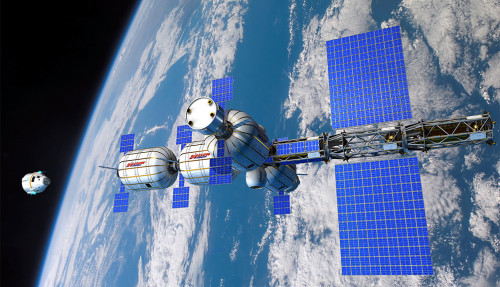
Artist’s impression of a space station comprising four B330 inflatable pods, which are the white cylinders. (Courtesy: Bigelow Aerospace)
By Hamish Johnston
It’s never been a better time to be a space enthusiast, as more and more countries are unveiling space programmes and it seems like a new mission is launched or announced just about every week.
But if you are like me and find the constellation of mission names – the various acronyms, mythical beasts and dead scientists – overwhelming, then the space physicist Chris Arridge has put together “Five human spaceflight missions to look forward to in the next decade” for The Conversation.
Riding a laser beam to Alpha Centauri, how the Sun pushes on the Earth and 22 kinds of space tape

Stars in their eyes: Yuri Milner (left) and Stephen Hawking. (Courtesy: Bryan Bedder)
By Hamish Johnston
What to do if you have millions of dollars lying around and a keen interest in physics? The physicist turned Internet tycoon Yuri Milner has already spent some of his fortune rewarding leading scientists and funding research. His latest project is called “Starshot” and involves spending a cool $100m on sending a spaceship to Alpha Centuri – the closest star system to Earth at just 40 trillion kilometres away.
View all posts by this author | View this author's profile
The toll of a year in space, running a marathon on the ISS, skip-diving at CERN and more
By Tushna Commissariat and Michael Banks
“A year here is a really really long time,” says astronaut Scott Kelly in an interview (watch the video above) that he did on board the International Space Station (ISS) just a month before he returned to Earth in March this year. The retired astronaut is talking about the very real effects of spending a long period in space, specifically citing both the physical effects as well as the “psychological stress” involved. “During my time in orbit, I lost bone mass, my muscles atrophied and my blood redistributed itself in my body, which strained my heart. Every day I was exposed to 10 times the radiation of a person on Earth, which will increase my risk of developing a fatal cancer for the rest of my life. Not to mention the psychological stress, which is harder to quantify and is perhaps as damaging,” he says.
The comments were part of the announcement of his upcoming memoir, Endurance: My Year in Space and Our Journey to Mars, which will be published later this year. Despite the damming tone, Kelly is still a staunch supporter of manned spaceflight and missions such as those to Mars, he just has a much clearer view on the realities involved. Read more about his announcement over at the GeekWire website.
View all posts by this author | View this author's profile
How to cook the perfect steak, Bill Nye gets tangled about entanglement and the challenges of going to Mars

The wrong way: where is the liquid nitrogen and duck fat? (CC BY 2.0 _BuBBy_)
By Hamish Johnston
How do you cook the perfect steak? Materials scientist Mark Miodownik of University College London has the answer. To cook his medium-rare steak (pink in the middle with a seared coating on the outside), Miodownik first seals the steak in a vacuum bag and places it in a warm water bath until it reaches 55 °C. He then dips it in liquid nitrogen for 30 s to chill the outer layer without freezing the middle. If that wasn’t unconventional enough, he then throws it into a deep-fat fryer containing duck fat. The result? “A lusciously seared steak, medium rare all the way through. And not a pan in sight!” says Miodownik. The BBC has put together a nice animation of the recipe: “What’s the weirdest way to cook a steak?”.
Soft hair on black holes, making concrete on Mars and exploring the cosmos in 2016
By Hamish Johnston
This week’s Red Folder looks to the cosmos, starting with a spiffy new video from the European Space Agency. The slick presentation is a preview of some of the extra-terrestrial exploits that the agency has planned for 2016. This includes the landing of the Schiaparelli probe on the surface of Mars. This stationery lander will survey its Martian environs to find a suitable location to drop the ExoMars rover in 2018. The mission’s namesake is the Italian astronomer Giovanni Schiaparelli, who mapped the surface of Mars and was the first to use the term canali to describe the straight lines that were thought to exist on the surface of the planet.
It’s possible that someday humans will colonize Mars and this will involve building dwellings and other structures on the Red Planet. In preparation, Lin Wan, Roman Wendner and Gianluca Cusatis at Northwestern University in the US have come up with a recipe for making concrete on Mars. The trio reckon that any successful colonization of the Red Planet will have to rely on local building materials because shipping stuff from Earth would be horrendously expensive.
Zapping head lice and a job that is out of this world
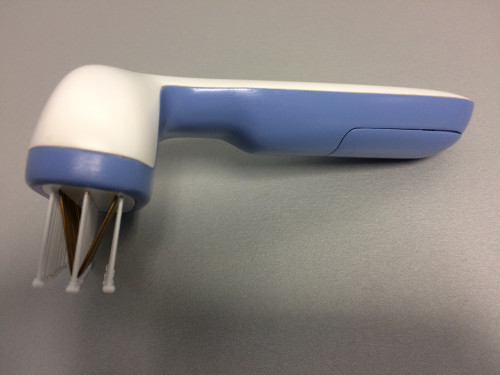
Nit picker: the cold plasma lice killer. (Courtesy: Fraunhofer IST)
By Hamish Johnston
Do your children have head lice again? Now you don’t have to comb their hair until your arm goes numb or cover their head with goop. Instead, you can zap them away using a plasma. I’m not suggesting that you put your child’s head into ionized gas that’s hotter than the Sun – it turns out that a “cold atmospheric pressure plasma” will do the trick.
That’s the claim of researchers at the Fraunhofer Institute for Surface Engineering and Thin Films in Göttingen, Germany. The team has created the above prototype, which creates a plasma using a high-voltage generator that sends short pulses to the teeth of the comb. The pulses ionize air molecules surrounding the teeth, but they are so short that the resulting plasma does not heat up. The charged ions and electrons in the plasma make short work of killing lice and their eggs, but are harmless to humans – at least according to Wolfgang Viöl and colleagues, who will be unveiling their device later this month at the MEDICA trade fair in Düsseldorf.
View all posts by this author | View this author's profile
Pushing towards the human–Martian frontier
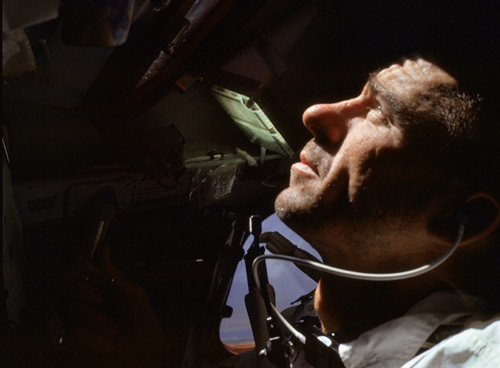
Eye on the sky: NASA astronaut Walter Cunningham during the Apollo 7 mission, in October 1968. (Courtesy: NASA)
By Tamela Maciel at the National Space Centre in Leicester
Last week, the planet Mars was under the international spotlight once more as NASA scientists announced that liquid water may still be flowing on the surface of the red planet. Also, the much-anticipated film adaptation of The Martian – a 2011 novel by American author Andy Weir – a science-driven story of human survival on Mars, hit the box office. Mars was also the hot topic at a recent event held at the National Space Centre in Leicester. The guest of honour was Apollo 7 astronaut Walter Cunningham and throughout the hour-long Q&A, he emphasized the need to push the “next frontier” and send humans to Mars.
Cunningham is not a man lacking in confidence or the experience of pushing boundaries. When asked if he ever felt the pressure of the astronaut selection or training process, he said “I thought I could fly anything, any time, anywhere. Was that true? I don’t know. But that’s how I felt.”
View all posts by this author | View this author's profile
Whisky in space, methane-capturing coffee, conference disasters and more
By Hamish Johnston
Fancy a wee dram while you are orbiting the Earth? With the growing interest in space tourism, travellers could soon be enjoying a sip or two of whisky in space. To make such tipples as enjoyable as possible, the Scotch whisky maker Ballantine’s has developed a special “space glass” that works in the free-fall conditions of Earth orbit. The firm is also developing a special blend of whisky to be enjoyed in space.
Created by Ballantine’s master whisky blender Sandy Hyslop and James Parr from the Open Space Agency, the new glass was filled with Scotch and tested in free-fall at the ZARM drop tower in Bremen, Germany. You can find out more about how one’s palate changes in space and the challenges facing the glass designers in the above video. And if you want to know if the glass passed the free-fall test, there is a second video called “Space Glass Project: the microgravity test”.